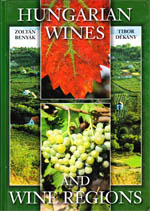Pannonhalma-Sokoroalja
View Pannonhalma-Sokoroalja in a larger map
Pannonhalma-Sokoroalja is one of the oldest wine-producing areas in Hungary. Documentary evidence attests to a flourishing viticulture in the villages and holdings of the Benedictine Abbey on Szent Marton Hill, at the early date of 997 A.D., just one year after the foundation of the Hungarian state. More than a millennium ago, the founding charter of the Abbey itself enshrined the privilege of making wine. The Benedictine priests provided the dwellers with guidance on tending the vines, not only from the pulpit but in the vineyards as well. In the 19th century, a number of smaller growers with commercial production established themselves in the shadow of the Abbey’s great estate, but the process of diversification was cut short by the scourge of phylloxera. In 1990, after a long period of dormancy, the area received wine region status in recognition of its awakening viticulture. Having been supplemented by another two villages in 1997, Pannonhalma nowadays has a number of cooperatives and smaller growers to burnish the region’s name.
Like most white wine areas in Hungary, Pannonhalma is dominated by the Olaszrizling grape and, at a distant second, Rizlingszilvani. Historically, Rajnai Rizling was quite influential here, but has lost much of its importance today. Other varieties planted in appreciable quantities include Chardonnay, Ezerfurtu, and Tramini. The wines, typically cold-fermented, are lively and refreshing, with good regional character. In the 1980′s and 1990′s, the local cooperative still produced a Pannonhalmi Rajnai Rizling in the heavier, oxidative style. This wine — the region’s best-known product in former centuries — is now relegated to collections maintained by “wine museums.” More recent wines of note include the Barodombi Olaszrizling, the Pannonhalmi Olaszrizling, the Pannonhalmi Tramini, and the Pannonhalmi Chardonnay.
Throughout the region, the visitor will encounter cellars of the lik (“hollow”) type. These are actually cavities dug into the loess walls flanking the gulleys—locally known as horgas, a variant of horhos in standard Hungarian—that used to serve as storage for tools and wines, and even as makeshift dwellings for the growers. The most representative examples can be seen near the villages of Gyorujbarat, Nyul, and Ecs.
Area: 630 hectares.
Climate: moderately dry, moderately warm, mild winter.
Vine varieties, wines: Italian Riesling, Rhine Riesling, Tramini, Chardonnay, “Irsai Oliver”. The white wines are of excellent quality, they are rich in fragrance and bouquet and have a strong region character.
For more interesting information |
|
Hungarian wines and wineregions. Authors: Zoltán Benyák, Tibor Dékány. |
Terra Benedicta 2003: Tokaj and Beyond Authors: Rohály Gábor, Mészáros Gabriella, Nagymarosy András. |
